Triggers - Appointment
- Get Started
- Release Notes
- Triggers
- Patient Channel
- Troubleshooting and FAQ
- Patient Facesheet
- Technical Specifications
- Insights & Analytics
- Inbox
- Conversation Flows
- Campaigns
- Lines & Resources Requests
- Lines, Events, Resources
- SMS Basics
- Automations
- Referrals
- AI Agents
- Add-Ons
- Users and Groups
- Platform Settings and Configuration
- Self-Rescheduling
- Recalls
- Marketplace
- Artera Harmony Federal Edition
Table of Contents
Triggers Create a New Appointment Trigger Configure Artera PracticesConfigure FiltersReview Filters Configure Trigger MessagingMerge MessagesSet Appointment Trigger TimingAppointment TriggersTCPA GuidelinesReview TriggerManaging TriggersFAQsTriggers allow you to build automatic appointment reminders, appointment confirmations, and no-show/cancellation workflows. These Triggers are designed to reduce appointment management overhead, decrease no-shows, and increase patient preparedness.
As an Enterprise User, you can configure Triggers that can be used across your Practices. This functionality allows you to set a standard for your organization controlling both message timing and brand voice.
NOTE: This article focuses on how to configure Triggers for the Appointment Module.
Triggers
Appointment Triggers are centrally located and managed under Triggers. This allows Triggers (automated messages) to be sent based on Practice specifications like Events, Providers, Locations, and Lines while preserving an Enterprise-wide cadence and message content.
Page Overview
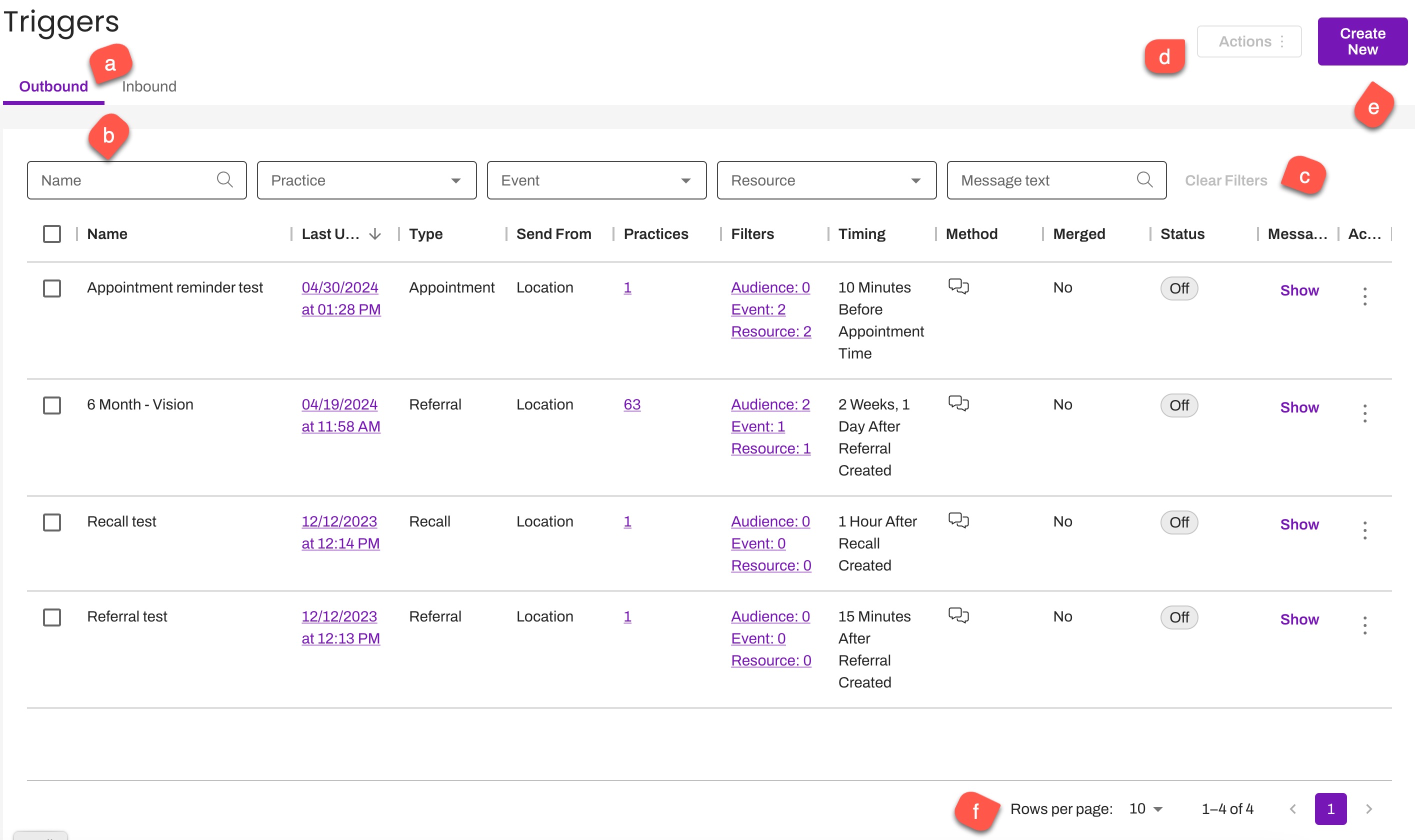
- Outbound and Inbound: Toggle between the Outbound and Inbound Message Conversation pages.
-
Trigger Details:
- Name: This is established when creating the Trigger and serves as the Trigger's title.
- Last Updated: This will display the last date and time the Trigger was updated.
- Type: This is the type of Outbound Trigger such as Appointment, Recall, or Referral.
- Send From: This is the Resource the Trigger should be sent from. Resource types are Provider, Location, Device, and General. Make sure the Resource(s) are connected with a Line. If you choose a Resource that has not been added to a Line, the Trigger will not be sent. Tip: Not sure how your Lines are configured? Navigate to Practice Settings > Lines and review the Resources added to the Line.
- Practices: This displays the total number of Practices configured to send this Trigger.
- Filters: This displays the total number of Audience, Event, and Resource Filters configured for this Trigger.
- Timing: This indicates when the Trigger will be sent.
- Method: The icons display which message types the Trigger can be sent by, This includes text, call, and/or email.
- Merged: This indicates if the Trigger has been configured to support Merged Messaging.
- Status: This indicates if the Trigger is On or Off and able to send messages.
- Message: Click this link to preview the text, phone, or email message content. This does not display any translations added to Triggers.
- Actions: Clicking the three-dot menu will allow you to Turn On/Off, Edit, Duplicate, or Delete the Trigger.
- Search Filters: Filter the Triggers page to locate Triggers by Name, Practice, Event, Resource, or Message Text. NOTE: Only one filter in each category can be applied at once.
- Bulk Actions: Select this button to turn Triggers on/off in bulk, saving you time and effort.
- Create New: Click this button to create a new Trigger.
- Rows per Page: Select how many Triggers per page you would like to see. Each Trigger will appear in a row.
Create a New Appointment Trigger
-
From the Navigation Bar, select Automations > Triggers.
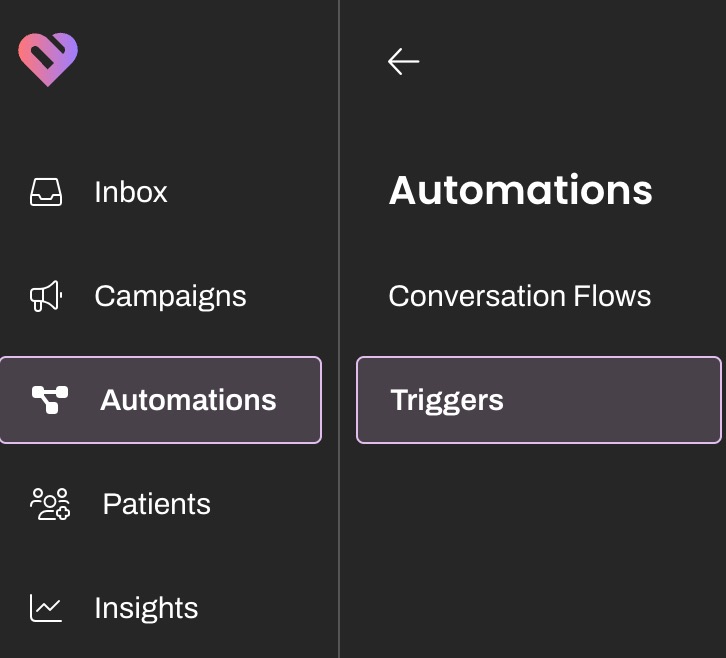
-
Select Create New in the top-right corner.

-
Add a Trigger Name. This will serve as the Trigger's title, so be sure to use consistent naming conventions. Next, leave Appointment selected from the Trigger Module drop-down and determine which Resource this Trigger should be sent from.
Tip: Resource types are Provider, Location, Device, and General. Many customers send by Location Resource.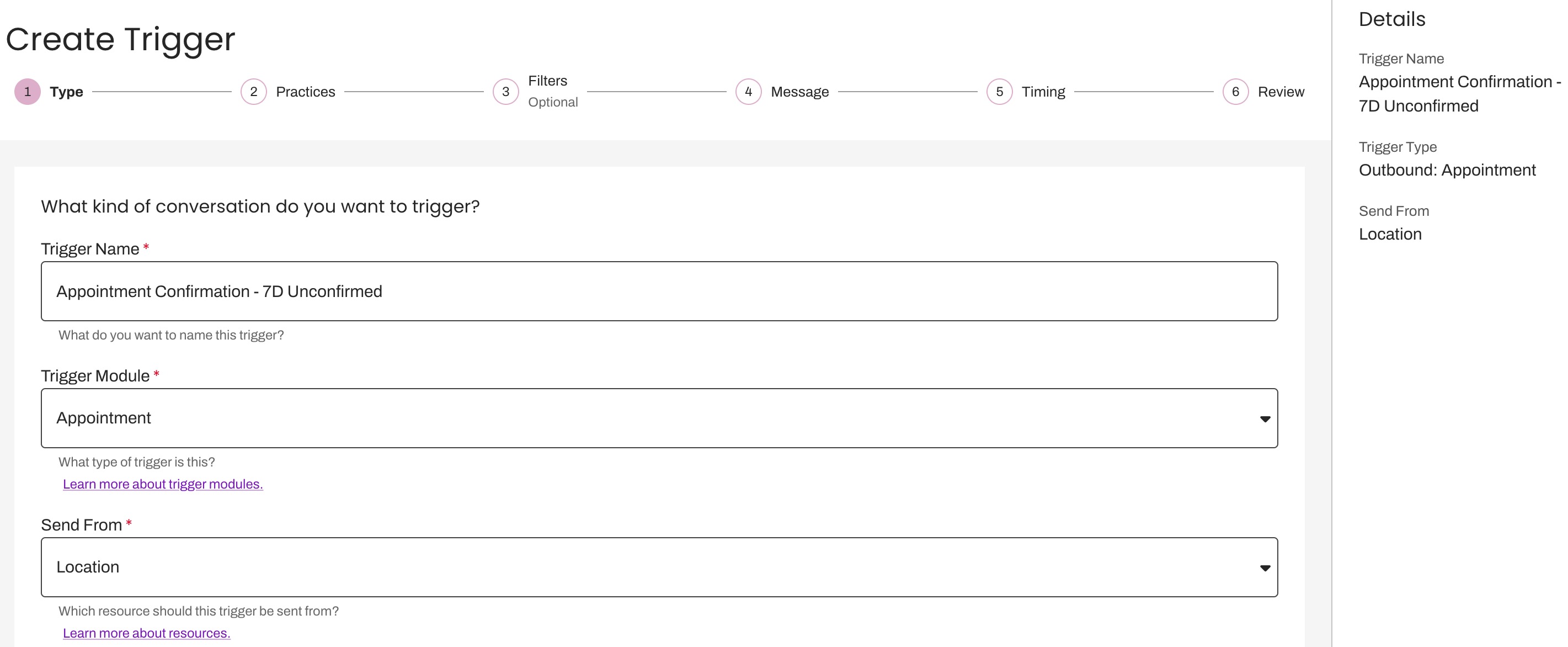
NOTE: As you progress through each step, the Details panel on the right-hand side will update with the Trigger's information.
Configure Artera Practices
Select the Practices that will send the Trigger. NOTE: By default, all Practices will be auto-selected.
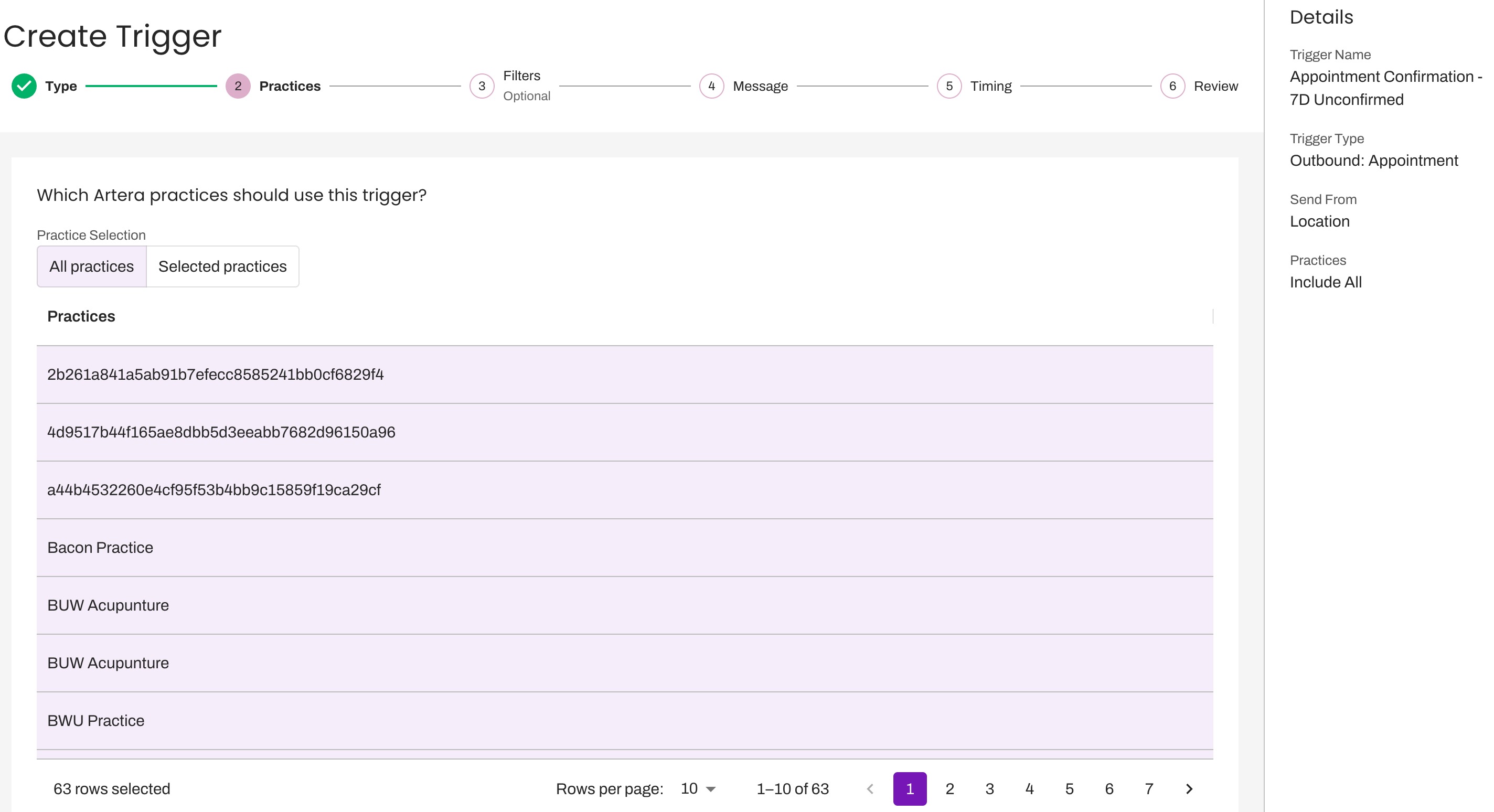
To locate specific Practices, click the Selected Practices tab and use the search bar to search by Practice name. Include Practices in the Trigger by using the check box near the appropriate Practice. Tip: Update the Rows per page up to 100 for larger Enterprises with many Practices.
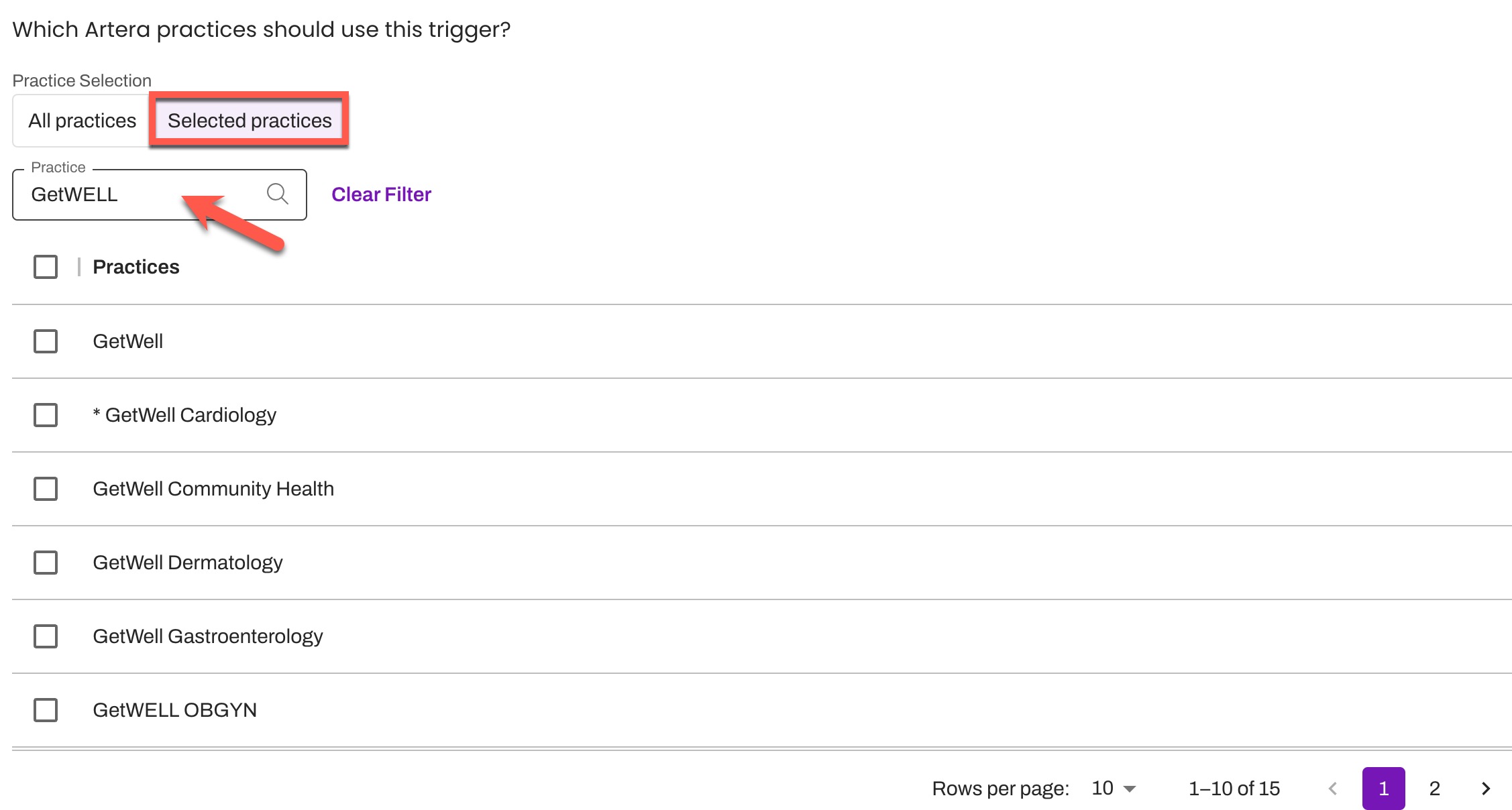
To bulk select your search results, use the check box located to the left of ‘Practices’.
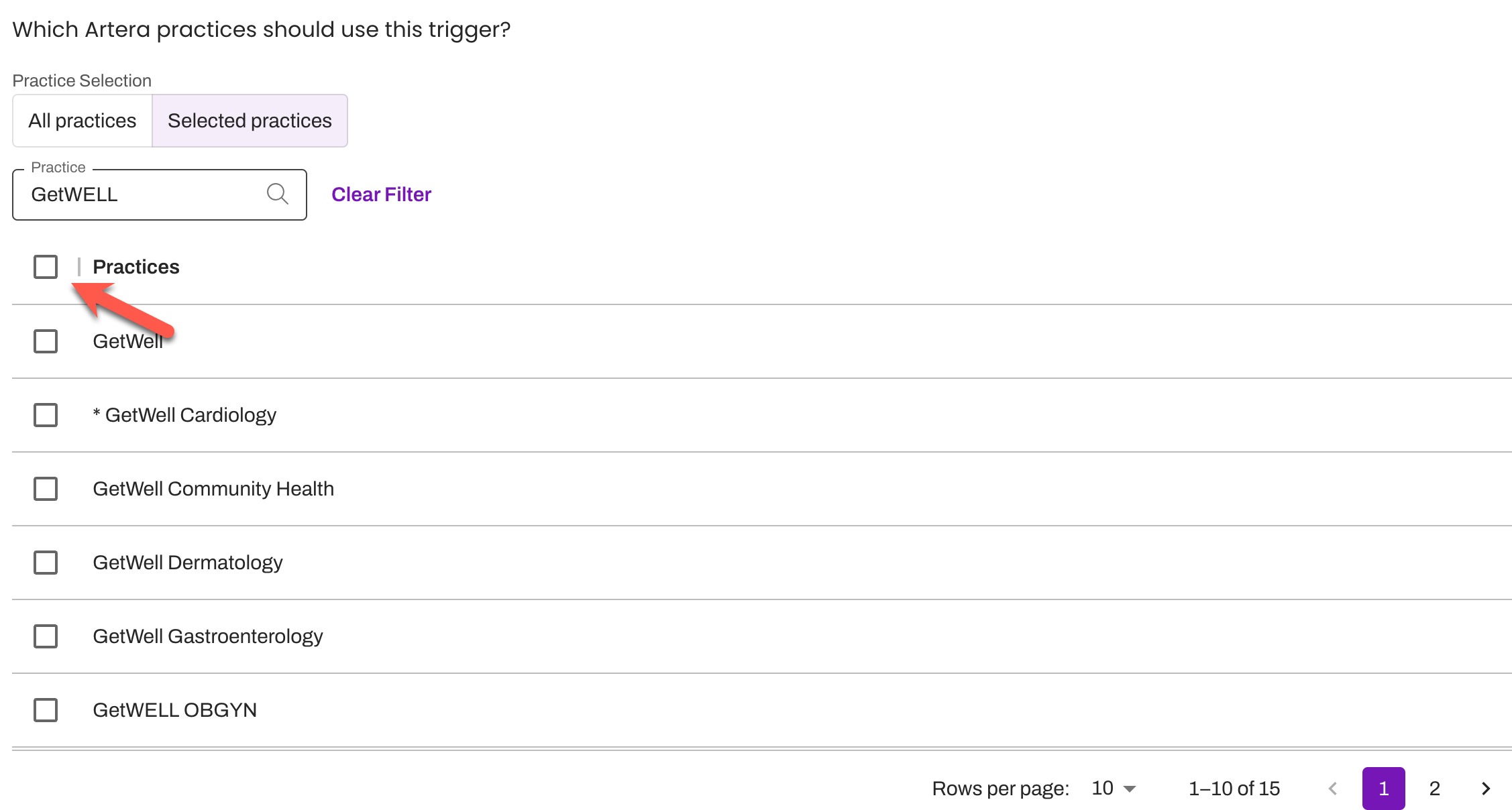
Configure Filters
Audience
-
Configure the Audience filters for the Trigger. This indicates the targeted patient population for the Trigger.
NOTE: If a filter field is left blank, the Trigger will not consider that filter in its logic.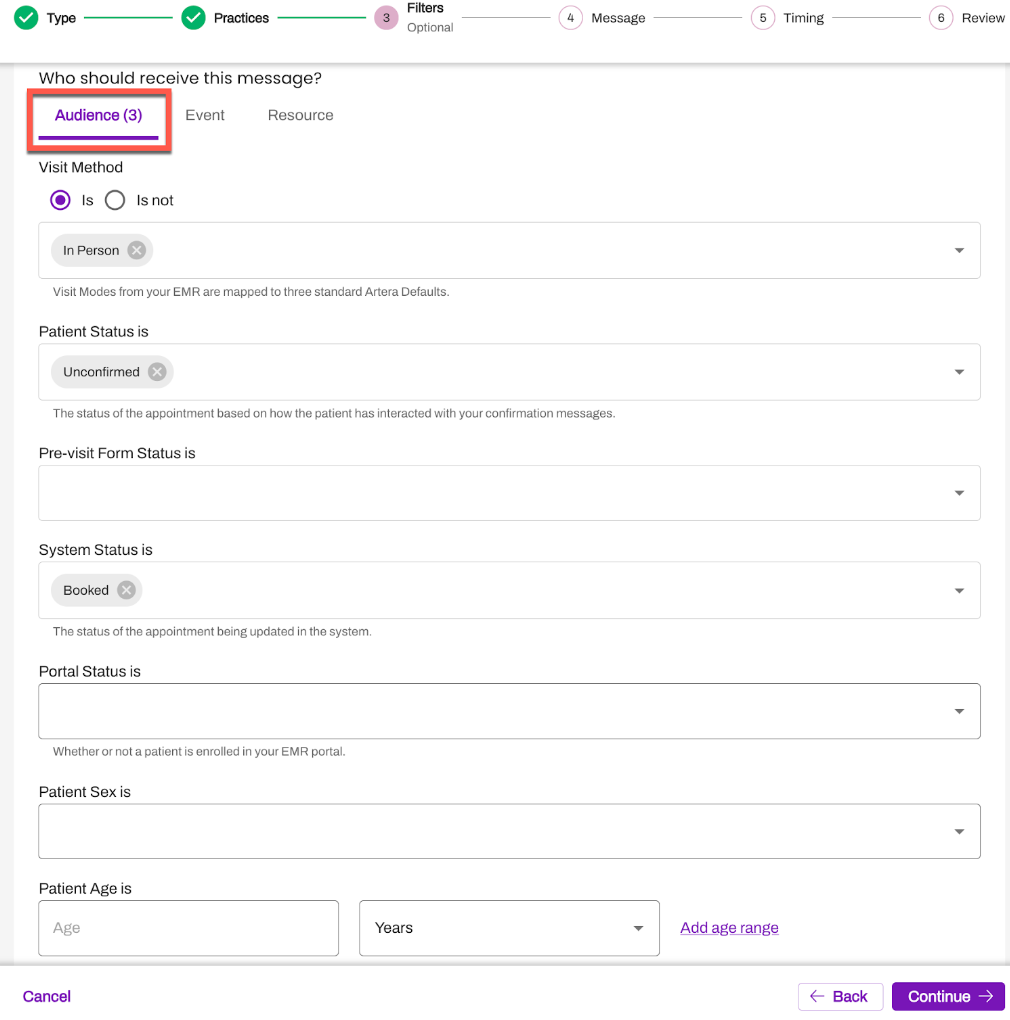
- Visit Method: This is applicable to Epic customers only. If you have implemented Visit Method as an add-on feature, use this option to identify which Visit Method (In Person, Telehealth, or Video) this Trigger is configured for. Tip: Use the radio button for Is to use inclusionary logic or Is Not allowing you to use exclusionary logic.
- Patient Status: These system-default statuses are mapped to the corresponding statuses in your EMR (Unconfirmed, Cancel, etc). They reflect patient-initiated responses to appointment reminders, such as confirmations. The available statuses are: Cancel, Confirm, Reschedule, Unconfirmed, View. NOTE: When configuring a Trigger based on a Patient Status of "cancel," ensure that it is not also set to send messages to patients with a System Status of "cancelled." Doing so could result in some patients receiving duplicate messages.
- Pre-visit Form Status is: This filter will only be visible to organizations who have implemented the Tonic integration for Pre-Visit Forms. Use this option to identify which status (Complete, Not Complete, Unknown/Other) this Trigger should be configured with.
- System Status: These appointment-specific statuses are system defaults mapped to the corresponding statuses in your EMR (booked, no-show, etc). They reflect EMR-initiated changes to appointments. For example, when an appointment is marked as "started" in the EMR. The available System Statuses are: Abandoned, Booked, Cancelled, Completed, No-Show, Started. NOTE: When configuring a Trigger based on a System Status of "cancelled," ensure that it is not also set to send messages to patients with a Patient Status of "cancel." Doing so could result in some patients receiving duplicate messages.
- Portal Status: These statuses indicate whether or not the patient is enrolled in your Patient Portal. Portal information is set up during implementation and not all EMRs support sending this data.
- Patient Sex: Segment your patient population based on Sex. You can choose a single option for this filter: Male, Female, or Unknown (where sex is not included or has been omitted).
- Patient Age: Use this filter to include the age of the patient as a restriction. This can be a specified value or an age range.
Event
-
Navigate to the Event tab and select the Events eligible for this Trigger. By default, all Events will automatically be selected.
NOTE: If a Trigger is configured with only one Event and that Event gets disabled, the Trigger will send to all patients. Therefore, it's important to ensure that you stop the Trigger if the Event associated with the Trigger is disabled. Click here to learn about disabling Events.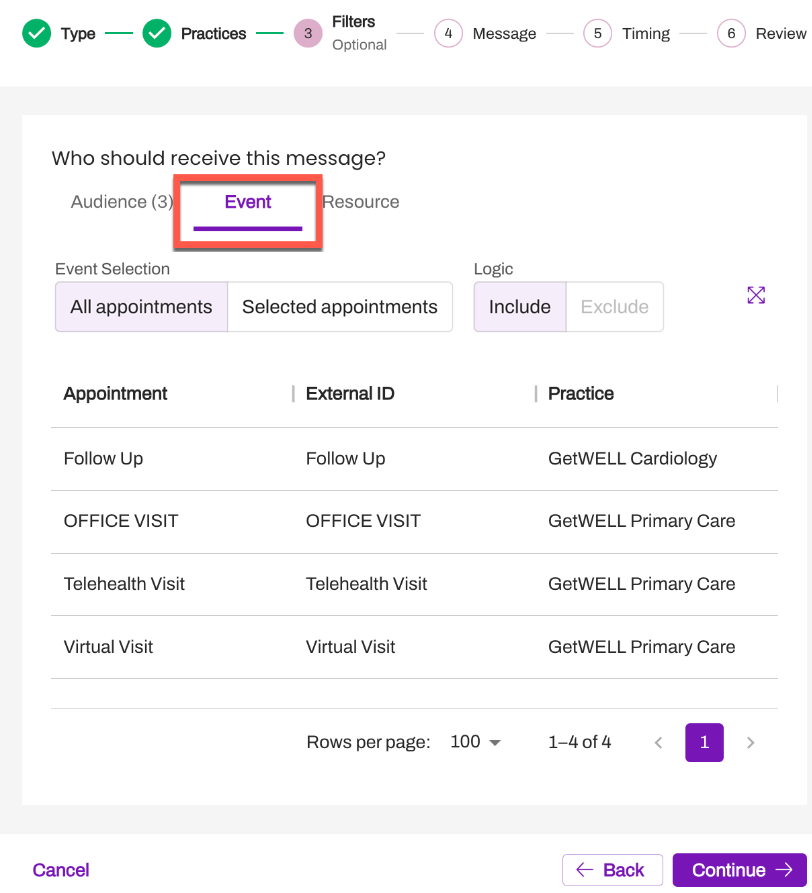
-
To locate specific Events across all of your Artera Practices, select the Selected appointments tab and use the search bar to search for Events.
- Appointment: This is the name of the Event
- External ID: This External ID matches the Event ID from your EMR
-
Practice: This is the Practice where the Event is located
-
Use the search bar to locate your Events. Include Events by using the check box next to each Event.
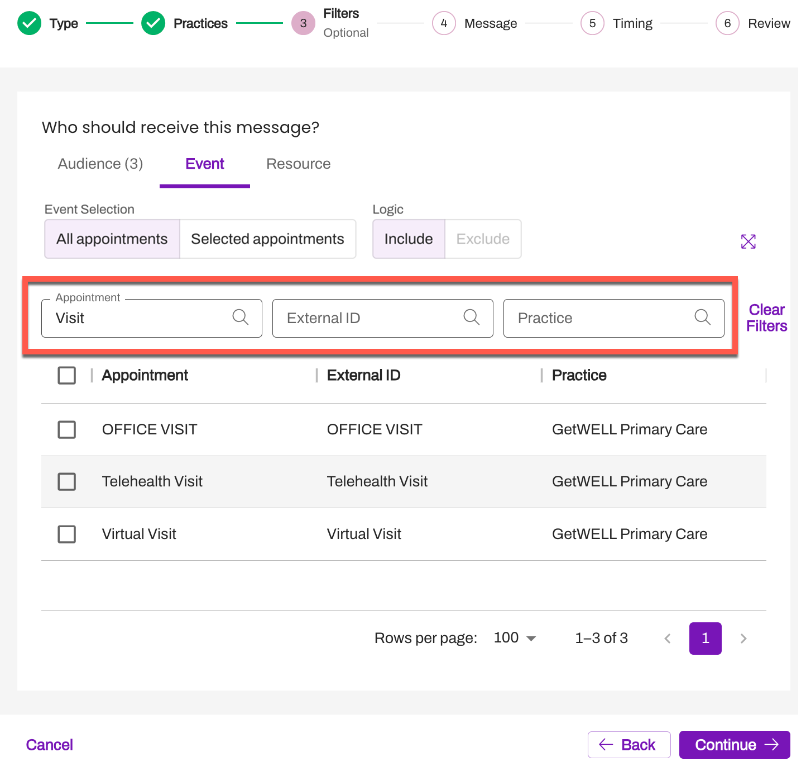
- To bulk select your Event search results, use the checkbox located next to Appointment.
- To maximize your view, use the Expand icon and a new window will open.
-
Use the search bar to locate your Events. Include Events by using the check box next to each Event.
-
Determine if the Events selected should follow inclusionary logic by selecting Include or exclusionary logic by selecting Exclude. In some instances, it may be easier to exclude the Events or Resources that you do not want to send a Trigger to rather than to include all the ones you do.
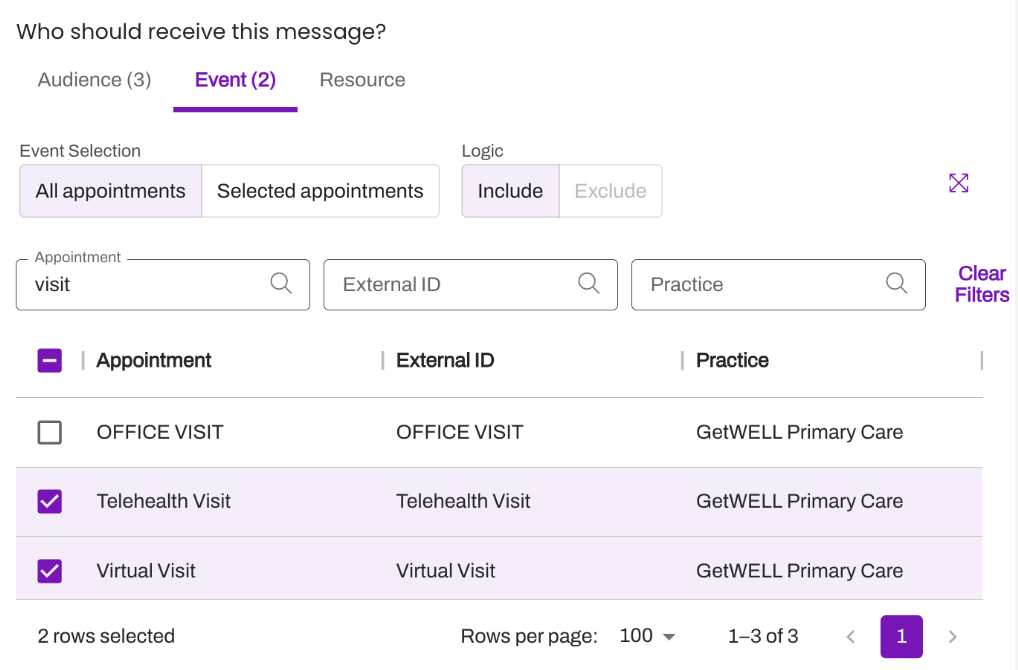
-
To locate specific Events across all of your Artera Practices, select the Selected appointments tab and use the search bar to search for Events.
Resource
-
Navigate to the Resource tab and select the Resource filters eligible for this Trigger. NOTE: If a Trigger is configured with only one Resource and that Resource gets disabled, the Trigger will send to all patients. Therefore, it's important to ensure that you stop the Trigger if the Resource associated with the Trigger is disabled. Click here to learn about disabling Resources.
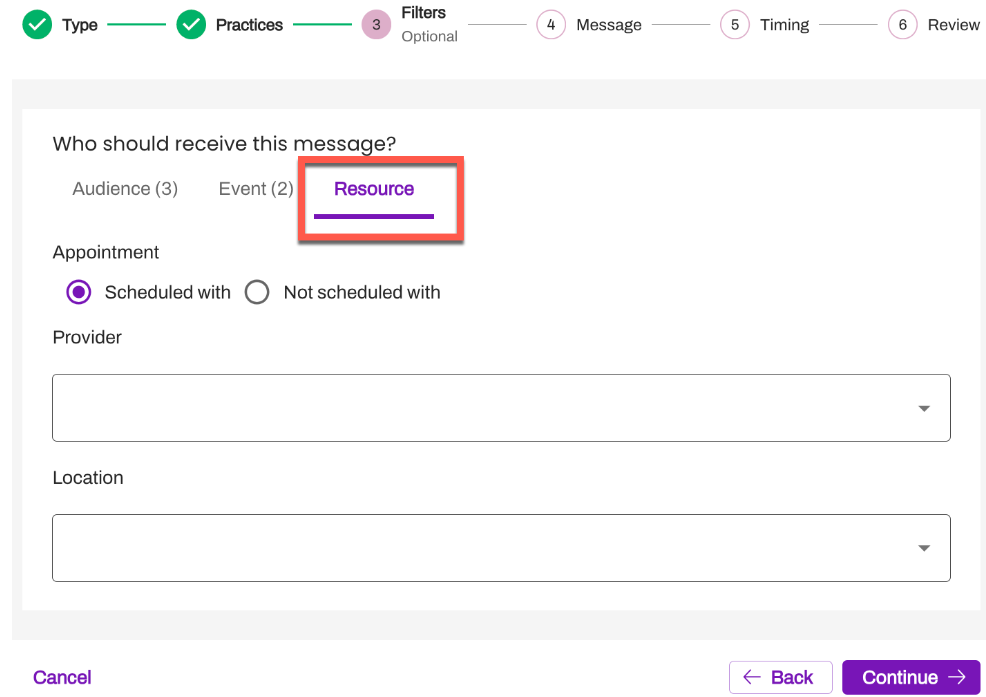
-
Provider: Use the drop-down menu or manually type to locate specific Providers across all of your Artera Practices. Include Providers by using the checkbox near the appropriate Provider. To bulk select Providers, check Select search results.
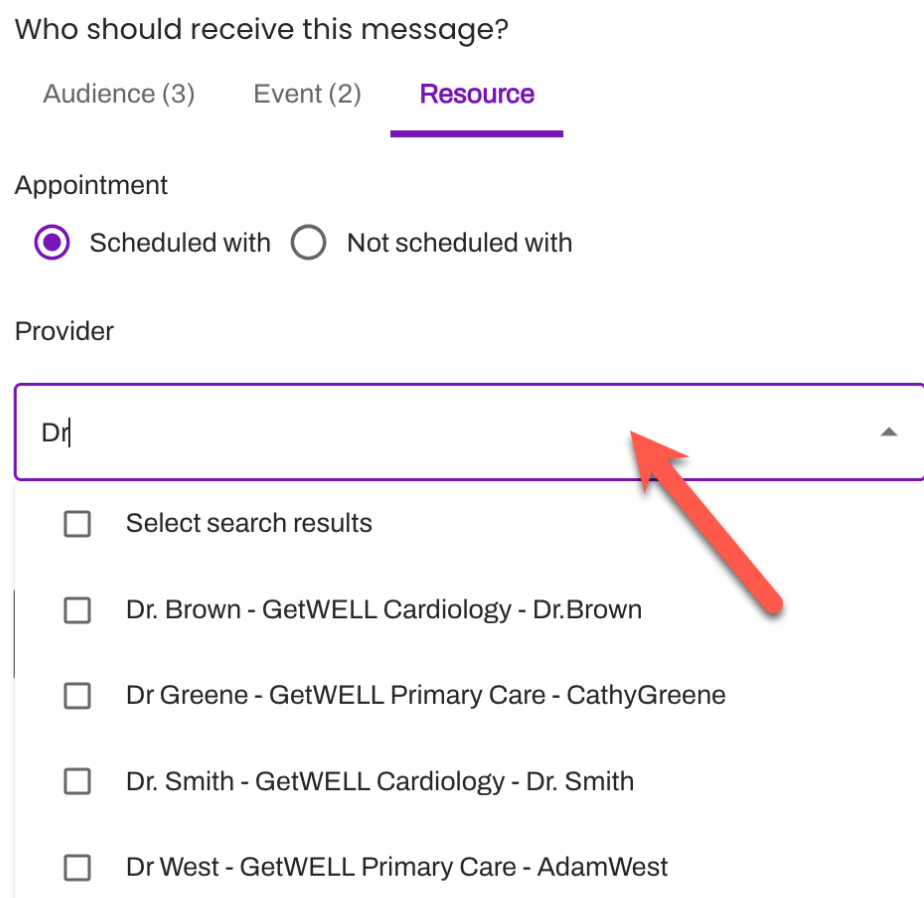
- Location: Use the drop-down menu or manually type to locate specific Locations mapped to your Artera Practices. Include Locations by using the checkbox. To bulk select Locations, check Select search results.
- Determine if the Resources selected should follow inclusionary logic by selecting the radio button Scheduled with or exclusionary logic by selecting Not scheduled with. Click here to learn more about Restriction Statements.
-
Provider: Use the drop-down menu or manually type to locate specific Providers across all of your Artera Practices. Include Providers by using the checkbox near the appropriate Provider. To bulk select Providers, check Select search results.
Review Filters
Before you proceed to the next step, review your selected Filters. Do note that if you selected any Practice that does not contain the Event(s) and/or Resource(s) applied when filtering, that Practice's patients will still receive the Trigger's message as Practices override Filters. This could result in patient confusion. Be sure to only select Practices where the Event and Resource filters applied exist. To prevent patients from receiving an incorrect Trigger, remove any selected Practice(s) that do not have these Events and/or Resources.
To identify which Practices should be included:
-
Review the Details side panel and select the "Include #" hyperlink beneath Event Filters and/or Resource Filters.
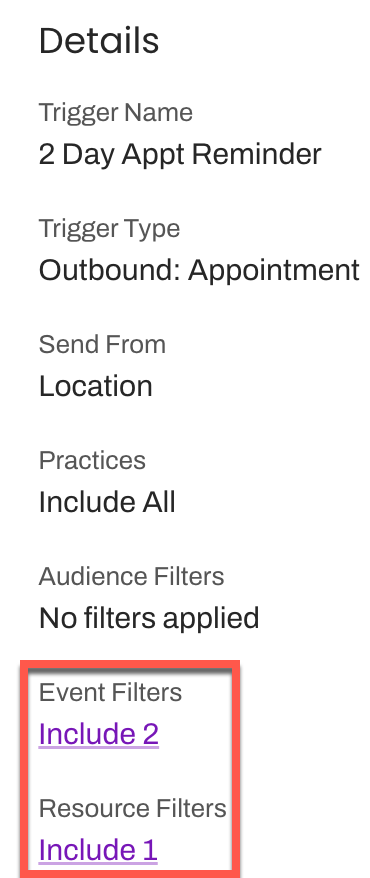
-
The Practice(s) in which the Event or Resource Filters exist in will display in a bulleted list. The order of information displayed in a bullet is: Event or Resource Filter name, Practice name, Event or Resource External ID.
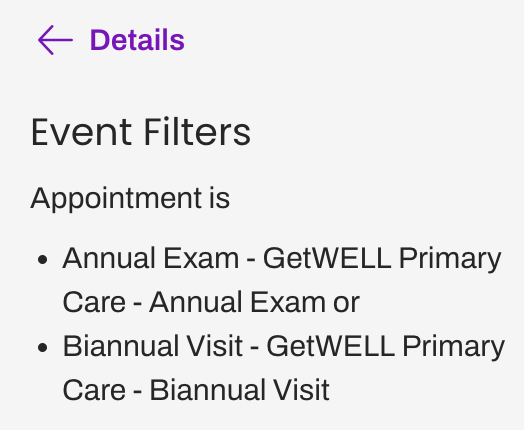 NOTE: If there are 100 or more Filters applied to a Trigger, the Details side panel will not display a complete list of Practices that include those items.
NOTE: If there are 100 or more Filters applied to a Trigger, the Details side panel will not display a complete list of Practices that include those items..png)
Configure Trigger Messaging
Next, you will enter the Trigger's message for each of the outreach methods you will support. Available outreach methods includes text, call, and email. Messages can be customized for each delivery method. You can choose to send Appointment Triggers by a single delivery method or you can configure these Triggers to be sent via all three delivery methods to increase deliverability. If you select multiple delivery methods for your Trigger, the patient will never receive all three. How the patient receives the message is based on their Patient Communication Settings.
We recommend keeping text content short in order to optimize the patient experience. Emails can be longer and require a subject line. Voice calls should be configured to be more conversational. When a patient receives an automated phone call, they must answer with "hello" or another greeting to prompt the message to begin.
NOTE: Artera uses answering machine detection to listen to the answered greeting of the call and determine whether or not to deliver the message as a voicemail. For more information, click here.
Text messages must be under 1,600 characters, otherwise, the message will fail to send to the patient. Learn more about SMS Character Limits and Message Formatting Guidelines. Click here for a deep dive into crafting a message to support multiple languages or adding attachments.
Tip: Check out our recommended message scripts in the Appointment Conversation Leading Practices article.

Quick Responses
Save time crafting your Appointment Trigger's message by leveraging your Enterprise's existing Default-level Quick Responses.

Attachments
Send attachments to your patients including PDFs, images, short videos, and forms. Attachments are helpful in cases where patients require more in-depth information such as detailed peri-procedural instructions before or after their visit. For more information on including attachments in a Trigger, click here.

Merge Messages
When a patient has multiple appointments on the same day within the same Practice, you can use Merge Messages to prevent the patient from receiving duplicates. For example, a Follow-Up Thank You Trigger sends for all appointments across providers. If a patient has two appointments on the same day (e.g. a consultation and a biopsy), you can use this setting to ensure the patient only receives one Thank You message. Click here to learn more about Merged Messages.
Configuring Merged Messaging
To set up Merge Messaging for the Trigger, use the radio button to select Yes. A new template box will appear, allowing you to enter the Merged Message copy.
NOTE: If your Trigger is set up for multiple delivery methods, you will need to create a Merged Message copy for each delivery method before continuing to the next step.
NOTE: If you translated the original Trigger message into multiple languages, you will only have the ability to create a Merged Message in those specific languages. If you would like to include additional translations in a Merged Message, you must first include that translation to your original Trigger message.

Merge Messages Considerations
You cannot merge multiple distinct Triggers. For instance, if one Trigger is set up to send a reminder for Dr. Jacobson and a second Trigger sends reminders for Dr. Smith at a separate Practice, the patient would still receive two messages: one for Dr. Jacobson and one for Dr. Smith.
Triggers configured to send from different Lines can be merged as long as they are in the same Practice.
You cannot attach a Form to a Merged Message.
Merged Messages respect patients, not phone numbers. So, even if two patients who share a phone number have the same type of appointment on the same day, the messages will not be merged.
Set Appointment Trigger Timing
Next, determine when the Appointment Trigger should be sent to the patient (e.g. 2 Days Before the appointment, 4 Hours After the appointment, etc.).
For Appointment Triggers, there are six message events (see below) and associated send rules. You can indicate a specific amount of time to offset the Appointment Trigger for two of the six message events, Appointment Time and Appointment Created.
Check out this article for our leading practice recommendation on Appointment Trigger timing.
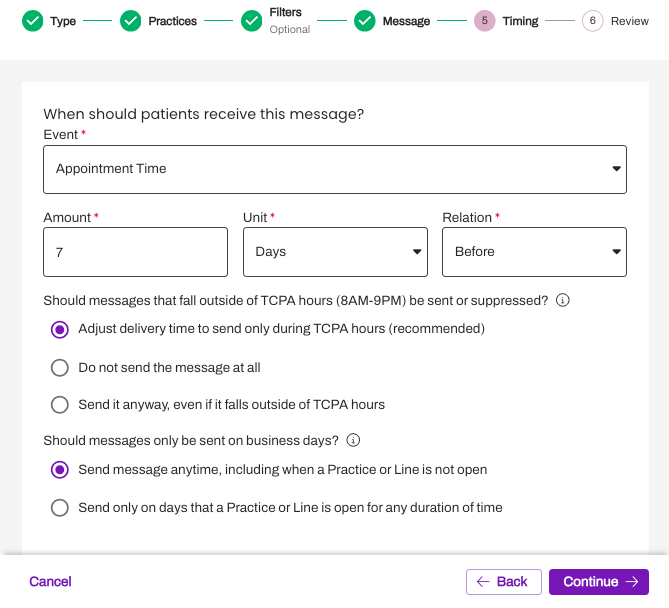 Appointment Triggers
Appointment Triggers
- Appointment Time: Send the Appointment Trigger based on the patient's scheduled appointment time (e.g. Send reminder 1 Day Before Appointment Time). So, if the patient has a 2:30PM appointment, the 1 Day Reminder will go out at 2:30PM the day prior to the appointment.
- Appointment Created: Send the Appointment Trigger based on the appointment being created in your EMR. The Trigger will send once the integration message is received in Artera (e.g.: send Instant Booking 15 minutes after Appointment Created).
-
System Status Change: Send the Appointment Trigger to the patient based on the status of the appointment being updated in the EMR (e.g. send a message when the System Status changes from "Booked" to "Cancelled"). During implementation, your EMR statuses are mapped to the corresponding default Artera statuses. When configuring a Trigger to support System Status Changes, the available "From Statuses" are: Abandoned, Booked, Completed, No-Show, and Started. The available "To Statuses" are: Abandoned, Booked, Cancelled, Completed, No Show, and Started. NOTE: When configuring a Trigger to send to patients based on System Status of "cancelled," ensure that the Trigger is not also configured to send to patients with a Patient Status of "cancelled." Doing so could potentially cause some patients to receive duplicate messages.
- NOTE: Since your EMR may not be able to send all of these statuses to Artera, only the supported statuses will be mapped.
- Date or Time Change: Send the Appointment Trigger to the patient if the date or time of the appointment is changed (e.g. appointment was rescheduled to a different day). This will only be sent if your integration can send these values to Artera and if the original appointment was updated. If you cancel the appointment in your EMR and schedule a new one, Appointment Triggers configured with the 'Date or Time Change' event will not be sent. Learn more here.
- Location Change: Send the Appointment Trigger to the patient if the Location of the appointment is changed (e.g. appointment was moved to a different facility due to renovation). This will only be sent if your integration can send these values to Artera and if the original appointment was updated. If you cancel the appointment in your EMR and schedule a new one, Appointment Triggers with the "Date or Time Change" event will not be sent. Learn more here.
-
Patient Status Change: Send the Appointment Trigger when the patient's appointment status changes in Artera (e.g. send a message when the Patient Status changes from "unconfirmed" to "confirmed.") This change can occur when the patient responds to an appointment reminder or when a user updates the appointment status on the Patient Facesheet. NOTE: If you are configuring a Trigger to send to patients based on Patient Status of "cancelled," ensure that the Trigger is not also configured to send to patients with a System Status of "cancelled." Doing so could potentially cause some patients to receive duplicate messages.
- Tip: When using Patient Status Change, we recommend selecting all statuses available in the "From" column. So, if you want the Appointment Trigger to send to the patient immediately any time a patient’s appointment status moves to the status of confirmed, you will need to include all available "From" statuses (View, Cancel, Reschedule, Unconfirmed). Otherwise, if an appointment moves from unconfirmed > view > confirmed, it would inadvertently be excluded from the Trigger.
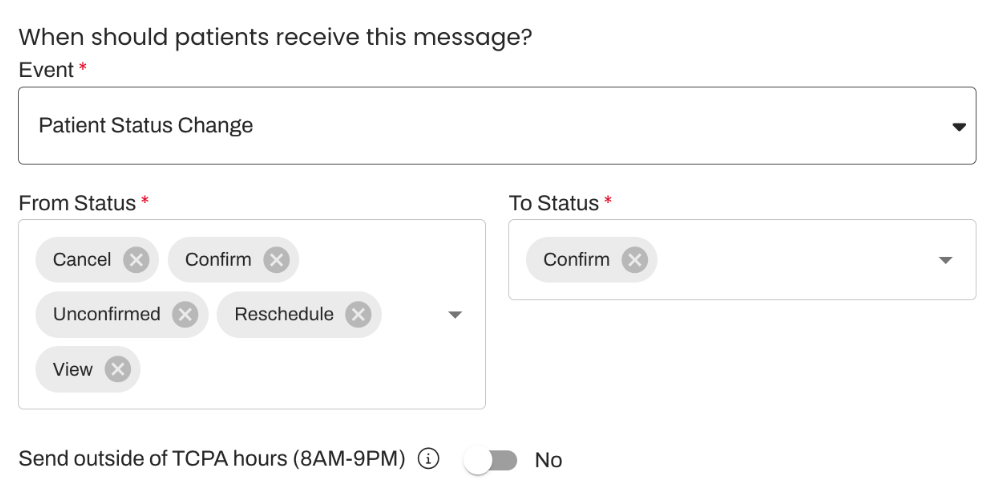
- Tip: When using Patient Status Change, we recommend selecting all statuses available in the "From" column. So, if you want the Appointment Trigger to send to the patient immediately any time a patient’s appointment status moves to the status of confirmed, you will need to include all available "From" statuses (View, Cancel, Reschedule, Unconfirmed). Otherwise, if an appointment moves from unconfirmed > view > confirmed, it would inadvertently be excluded from the Trigger.
Send Only on Business Days?
This rule is only available for Appointment Time or Appointment Created triggers. NOTE: This setting will be grayed out and cannot be enabled unless the automated Appointment Trigger is set to send at least 15-minutes after the chosen message event.
Business Days are determined by your Practice and line Hours. Any day that your Practice or line is open for any duration of time counts as a Business Day in Artera.
Impact
If you restrict an Appointment Trigger to send only on Business Days and the message is set up to send 1 Day Before the Appointment, appointments that fall directly after the weekend will receive their reminders during your last business day.
For example, if your Practice is closed on Saturday and Sunday, reminders for Monday's appointments will be sent the Friday before the appointment rather than on Sunday.
Note: In Practices set up for One-Way messaging, all days are Business Days, so this toggle does not impact your Appointment Triggers.
Patient Status or System Status Change Ignores Business Hours
If you configure the Appointment Trigger to occur upon the message events of Patient Status Change or System Status Change (e.g. Appointment Confirmed), the Appointment Trigger will go out regardless of Business Hours. Instead, the timing of the message depends on when your system of record sends status updates to Artera.
For EMRs that send information in real-time, the message will go out when the patient responds to the Appointment Trigger's message, changing the status. For systems that complete a batch update once per day (typically overnight), we recommend avoiding using the System Status Change trigger when building Appointment Triggers.
For example: If Artera does not receive a No-Show status until after midnight, instead of creating a No-Show Appointment Trigger that uses a System Status Change from "Booked" to "No-Show", we would configure it to send 1 Day After Appointment Time. Then, when filtering at the Practice, we would add a System Status Restriction of "No-Show".
Suppress Conversation for same-day appointments?
When using the Appointment Created message trigger, you can choose to not send the patient an Instant Booking message for their appointment.

TCPA (Telephone Consumer Protection Act) Guidelines
Artera enables you to send or suppress automated reminders based on TCPA guidelines. Choose between sending the message immediately, scheduling the message within the TCPA guidelines, or not sending the message at all. Click here for a full breakdown of TCPA Hours and how it impacts messaging.

When considering Appointment Triggers, we typically recommend choosing to Adjust Delivery Time when available, which will respect TCPA hours.
Generally, most appointments fall within standard business hours, so that adjustment is typically minimal. For example, if the patient is receiving a reminder for their 7:30 AM appointment on Tuesday, the 1-Day Reminder will send around 8:00 AM on Monday.
Review Trigger
Review the details of the Appointment Trigger, ensuring all of the information is correct. To make changes, use Back to navigate through the Trigger steps.
Tip: To review the Trigger in different languages, use the drop-down menu located under Message.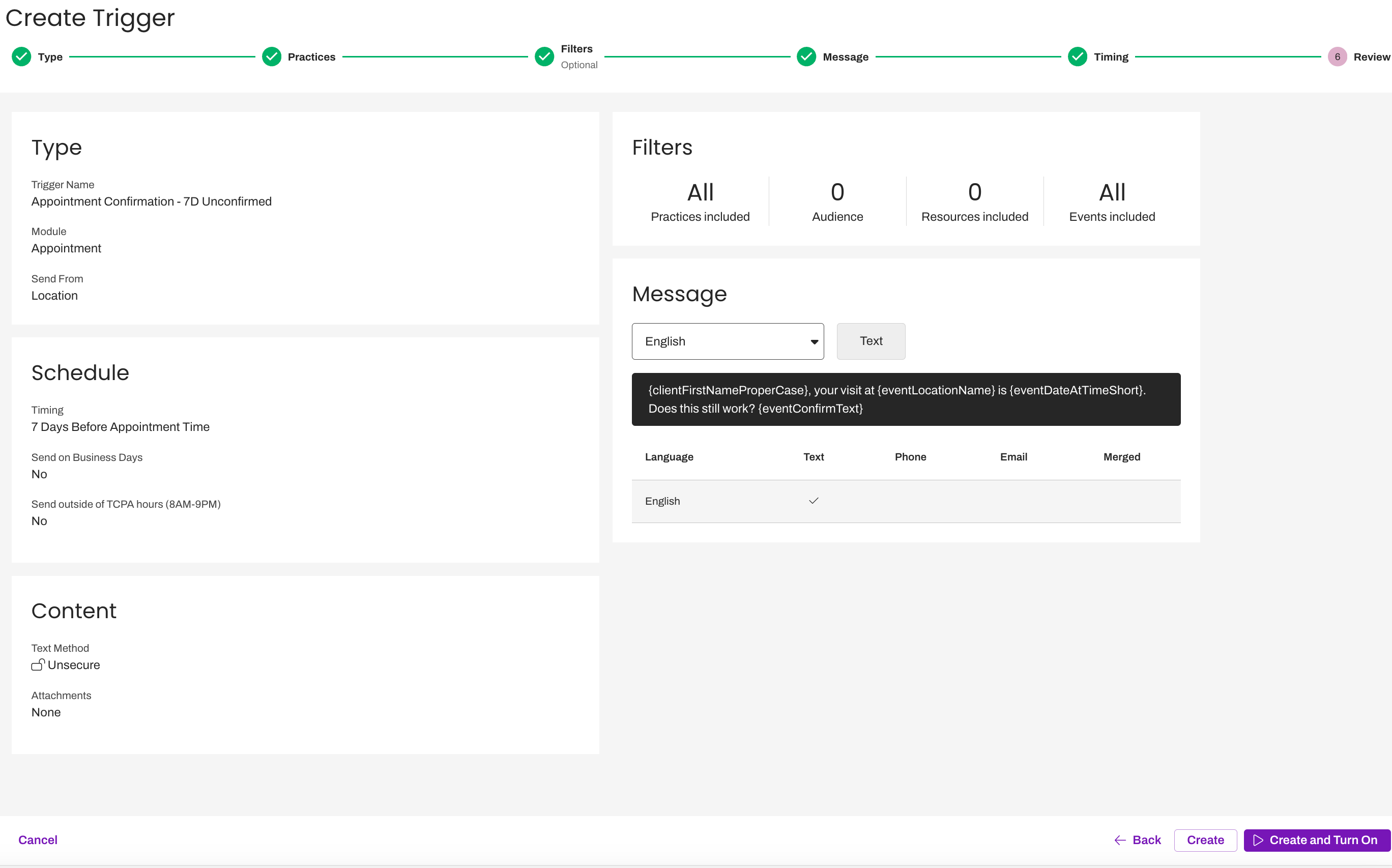
Click Create to finish creating the Appointment Trigger or Create and Turn On to finish creating the Appointment Trigger and allow it to start sending messages to patients.
Managing Trigger
It is important to have an Appointment Trigger strategy to ensure that your Triggers stay up to date over time. Click here to learn more.
Editing a Trigger
As an Enterprise user, you can edit Appointment Triggers so that the Triggers are updated for all Practices that use them:
Navigate to Triggers.
Select the Appointment Trigger you wish to edit by clicking its three-dot Action menu on the right side and choose Edit.
Change desired section: Trigger Type, Trigger Content, Trigger Timing, or Trigger Aggregation.
Select Update when done to save your changes.
Creating Triggers From Template
You can create Triggers and then use them as a template for new Triggers that have similar functionality.
This is especially helpful when creating Event-specific Triggers, e.g., copying the Appointment Confirmation - 7D Unconfirmed to use for the Virtual Visit Confirmation - 7D Unconfirmed.
Go to the Actions menu of the Trigger you would like to copy by clicking the (...) Actions menu. Select Duplicate.
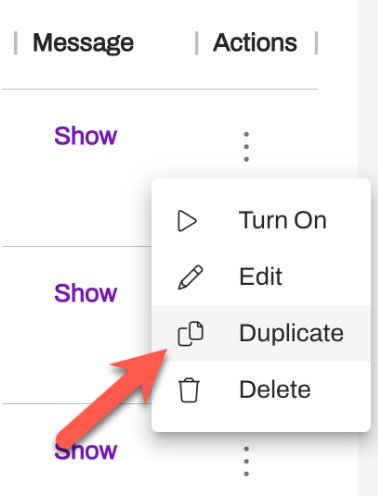
Edit the appropriate sections.
Once you have reviewed your Trigger, click Create or Create and Turn On.
FAQs
I do not see an existing Event, Location, Provider, or General Resource as part of my results under Filters, what do I do?
During Step 2, make sure that you have included the Practice where those Events or Resources are located. Events and Resources will only show for the Practices you have selected during Step 2.
If you have included the right Practices, reach out to your Artera Representative for further assistance.
I created an Appointment Trigger, do I need to navigate to the Practice-level to enable it?
All Triggers are now centrally located and managed through Triggers. You will no longer need to go to a Practice to build, configure, filter, and turn on a trigger.
If a patient's appointment is cancelled in the EMR, will an Appointment Trigger be delivered to the patient?
No, an appointment cancelled through the EMR will not send an Appointment Trigger to the patient. The cancellation must be initiated by the patient, with the use of cancellation keywords, through a cancellation response to an Appointment Trigger message.
A patient's appointment was rescheduled in the EMR. Will new Appointment Triggers be delivered to the patient?
If a new appointment was scheduled for the patient with a new appointment ID, a new set of Appointment Triggers will be delivered to the patient. However, if a patient's existing appointment is modified or rescheduled in your EMR using the same Appointment ID, Artera has the ability to send Triggers communicating this change based on specific scenarios. Click here to learn more about Appointment IDs and Rescheduling. `
